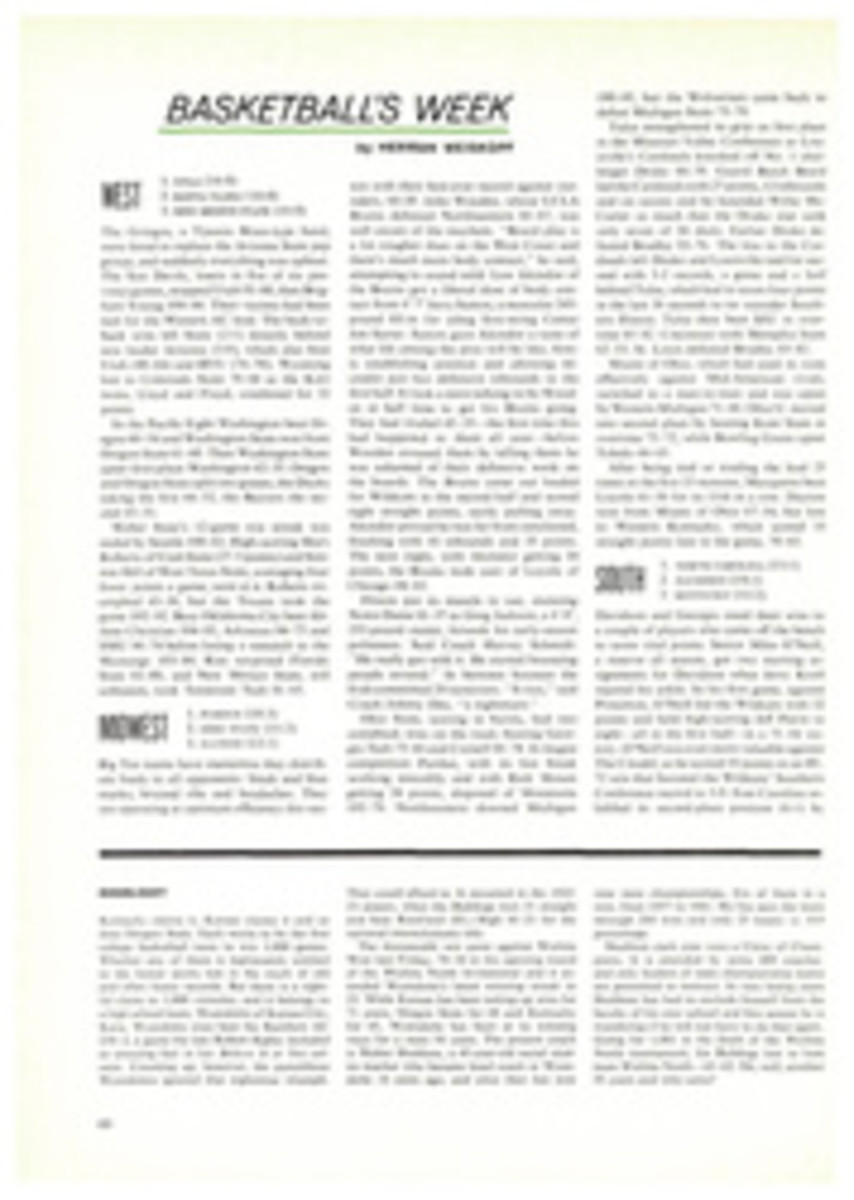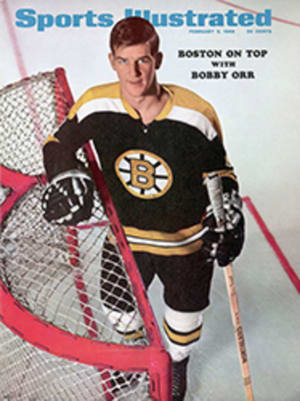
THE MEET OF THE FUTURE IS NOW
Under the spurious, latticed sky of Houston's Astrodome the U.S. Track and Field Federation put on last weekend what must surely be the indoor track meet of the future. For the present, however, the field, which was diluted by competing meets at Albuquerque, Oakland, Seattle and Philadelphia, was far less spectacular than the setting. The banked, baby blue wooden track (five laps to the mile) is the biggest indoor track in the world; the coral wooden straightaway for the 100-yard dash and the 120-yard high hurdles is the longest indoor straightaway in the world; and the banks of red, orange, purple, yellow and royal blue seats are, well, the most colorful seats in the world.
The track meet was sandwiched between a couple of bullfights, an NBA doubleheader and a rodeo, and the track was partly laid while the bullring still occupied center stage. The track was made in Boston and cost Judge Roy Hofheinz, the Astrodome's impresario, some $78,000 before it was all in place. It was announced that seven world records were set in the Dome, but some of them should, at best, be marked with an asterisk. Most indoor tracks run 11 or 12 laps to the mile, and indoor records aren't generally recognized if the track has fewer than eight laps to the mile.
In the Astrodome an indoor meet lacks some of the urgency and sense of participation that animates meetings in arenas like the old Madison Square Garden, where many spectators were close enough to shake hands with the cup race winners when they took their victory laps. Moreover, although the crowds at Houston were good by conventional standards—16,312 on Friday and 14,063 on Saturday—when they gave voice in the Dome, the noise drifted up to the lofty ceiling and faded away.
The track was a bit spongy on the turns but almost as satisfyingly resonant as the boards at the old Garden, and the pounding feet of the big fields in the relays produced the same gratifying thunder that excites indoor track fans in smaller arenas. And although there were some 29,000 empty seats, this dispelled rather than enhanced the gloom—you could see the gorgeous upholstery.
"I didn't expect to get my investment out on this meet," said Judge Hofheinz. "We have a five-year contract with the USTFF and, before it is over, this will be the biggest indoor meet in the world."
If one judges by Hofheinz' record, it probably will. In 1968, promoting everything from indoor motorcycle races to a Hubert Humphrey rally, he lured 3,499,900 people into the Astrodome. So far in 1969 he has had two bullfights and the track meet. Bullfights are by now an Astrodome feature; tucked away in what Hofheinz bills as the Eighth Wonder of the World are 16 mounted bull heads, and he has a whole stuffed bull on display at his ranch. What the judge is ever going to do with 16 bull heads is almost as much a mystery as what is to become of the 200 old Pullman cars he has parked on various sidings around town, although there is speculation that he will use the Pullmans during extravaganzas yet to come to house the overflow from the four motels he owns near the Dome.
Hofheinz has a commitment from the NCAA for the 1971 basketball championships and in 1970 he will hold the USTFF meet in mid-February. On this date he might come close to filling the Dome, which, of course, would set an attendance record for indoor track.
The meet last weekend was nicely run by Cleburne Price, who stages the Texas Relays, but only a handful of big names competed and some of these performed poorly. Bob Seagren, after getting an award from the USTFF as its "Athlete of the Year," went out of the pole vault at 16 feet, and Ralph Boston was second in the long jump with a puny leap of 24'4½".
The only names who came through were Willie Davenport, who set an automatic world record of 13.5 in the first 120-yard high hurdles ever run on boards, and Lennox Miller, who lowered Dave Sime's old record of 9.5 when he nipped Jim Green of Kentucky in the 100 in 9.4.
But Hofheinz' hopes for full houses for indoor track in Houston rest largely upon another 100-yard-dash winner. He is Kenneth Curl Jr., a 16-year-old junior at Houston's E. E. Worthing High School. Worthing is a Negro school, and Curl is an engaging youngster with an angelic expression, a wispy beard under his chin, which, he says, "I'm a little proud of" and more speed than Bob Hayes had at the same age.
After a sedentary start and under no great pressure, Curl won the high school division 100 in 9.6, a national high school indoor mark. His victory came as no surprise. Last year, at the age of 15, he ran a legitimate 9.5 and a wind-aided 9.3 and won both sprint championships in the Texas State High School Meet.
Curl is coached by Oliver Brown, who first met him at Crispus Attucks Junior High when Kenny was 12. "We'd have the boys run a 30-yard dash," says Brown. "The first three would be sprinters, the next three hurdlers and the next three quarter-milers. Kenny ran 4.2 or 4.3—easily the fastest. I don't have him broad-jumping now, but he did 21'11" when he was 14. In the 100 his knee lift and stride are perfect. He used to have a bunched start. I changed that, but now he has a tendency to swing his arms across his body."
Curl, who is nicknamed both Biscuit and Yuk Yuk, the former from a mistaken notion that he has a penchant for saltines, the latter because of his laugh, was a High School All-America in 1968, the fourth Brown has coached. "Ken can run a 9 flat in time," he says. "I never saw any sprinter who could match him at the same age, and he loves to work. He is a very serious competitor."
Curl is a serious student as well. He has a B+ average and takes algebra, chemistry, history, German and English. Next year he is going to study physiology and physics; he wants to be a doctor and at the moment leans toward Harvard. Half a dozen colleges have already approached him, but he has ignored them; Curl is exceptionally level-headed for one so young. For example, he could have gone to Washington High, where his father is an assistant principal (his mother teaches elementary school), but he chose Worthing because his teammates and Brown were there and he is determined to become the world's fastest human and to compete in the Olympics. "I look forward to it," Curl says softly, "the Olympics especially. That's the biggest track meet in the world. I guess if I won that, I would end my track career."
The football coach at Worthing, Johnny Peoples, wishes that Curl, who is 5'10" and weighs 161, would end it right now. "I have a rule that I will never issue a football uniform to any boy who doesn't come out from the beginning of practice," says Peoples. "If Kenny comes out in midseason, there's a uniform for him."
"They tried to get me to play football," says Curl. "But I want to go to college on a track scholarship. I know if I got out there on the football field, they'd try to break me in half because of what I have done in the 100. Then there wouldn't be any scholarship in football or track. Sometimes I wish I could play football, though. I see them running and catching passes and I know I could do the same thing."
Curl did have a fling at running for office last year but lost out by a few votes in the race for vice-president of the student council.
"They had the election two weeks after the state meet, and the training cut into my campaign," he says somewhat facetiously. "They kidded me a lot. Come up to me and say, 'How's the world's fastest human?' And I'd say, 'No, not now. Maybe next time.' "
Before his race in the Astrodome, Curl was notably loose. "I don't get nervous before a race," he said. "Sometimes guys try to psych me by saying they're going to beat me or I'm going to pull up lame, but I don't pay any attention to them."
Curl made one false start, stood fast through another, then got off late. He caught the leaders about 30 yards from the finish and pulled ahead easily with a fluid, floating stride reminiscent of Bobby Morrow's, to win by two yards.
"He hit a soft spot about 40 yards out," Brown said later. "That's where he usually cuts in the jets, and it shook him. He usually accelerates again between 60 and 80 yards and meets all challenges. His start might have been a little slow, because this is the first time he has run out of blocks since last May."
After his event Curl watched Miller win the open 100. Kenny was asked how he would have done if he had been in the race.
"I'd have done my best," he said.
Next year Curl's best should be about the best.
PHOTO
The Astrodome houses the world's largest (what else?) indoor track—-five laps to the mile—as well as the longest straightaway—135 yards.
PHOTO
Ken Curl, 16, may be the next fastest human.

